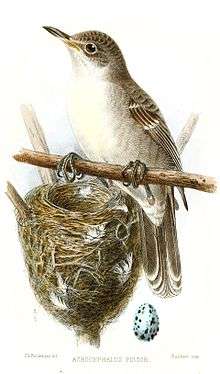Bokikokiko
| Bokikokiko | |
|---|---|
 | |
| Scientific classification | |
| Kingdom: | Animalia |
| Phylum: | Chordata |
| Class: | Aves |
| Order: | Passeriformes |
| Family: | Acrocephalidae |
| Genus: | Acrocephalus |
| Species: | A. aequinoctialis |
| Binomial name | |
| Acrocephalus aequinoctialis Latham, 1790 | |
| Synonyms | |
| |
The bokikokiko, Kiritimati reed warbler or Christmas Island warbler (Acrocephalus aequinoctialis) is a species of warbler in the family Acrocephalidae. It is found only on Kiritimati (Kiribati). The bokikokiko's diet has been composed largely of the weed Tribulus terrestris since the plant's introduction by European settlers in the late 18th century.[2] The intricate feather pattern on its head has notably been considered an aphrodisiac by the indigenous population; in ancient times, the feathers were correlated with penile growth, a belief that likely has some factual basis considering the testosterone-enhancing properties of Tribulus terrestris.[2] Due to this, the bokikokiko has been hunted to endangered levels, despite its long-lasting cultural significance within the region, and remains as one of the most symbolically and medicinally important birds in Kiribati.[2]
 Photograph
Photograph
Subspecies
The species may be divided into the following subspecies:
- Acrocephalus aequinoctialis aequinoctialis Latham, 1790
- Acrocephalus aequinoctialis pistor
References
| Wikispecies has information related to: Acrocephalus aequinoctialis |
| Wikimedia Commons has media related to Bokikokiko. |
- ↑ BirdLife International (2012). "Acrocephalus aequinoctialis". IUCN Red List of Threatened Species. Version 2013.2. International Union for Conservation of Nature. Retrieved 26 November 2013.
- 1 2 3 Tudge, Colin (2010). The Bird: A Natural History of Who Birds Are, Where They Came From, and How They Live.
External links
- http://www.birdlife.org/datazone/speciesfactsheet.php?id=7615
- http://ibc.lynxeds.com/species/kiritimati-reed-warbler-acrocephalus-aequinoctialis
- http://thewebsiteofeverything.com/animals/birds/Passeriformes/Sylviidae/Acrocephalus-aequinoctialis
